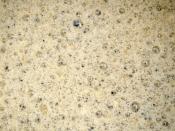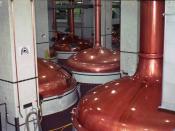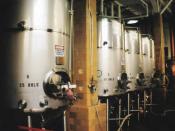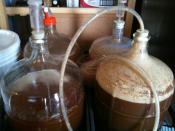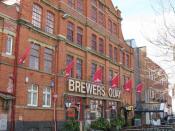Home brewing: A brief history In the beginning, all beer was home brewed. The exact origins of beer are unclear, but the earliest records we have of fermented beverages come from the Tigris-Euphrates valley eight thousand years before Christ was born.
No one knows when the first Sumerian peasant happened upon the idea of soaking hard barley kernels in water to soften them for eating. Similarly, no one can tell when the next peasant in that apostolic succession of home brewers deliberately or inadvertently left some of those soaked grains to dry, chewed on them, and discovered a delightful nutty and slightly sweet flavor. Furthermore, it is not clear when the next peasant ground those grains for bread and found that when soaked in water for several days the bread magically transformed the water into something not only drinkable, but also transporting.
Cuneiform records document brewing in Mesopotamia by 6000 B.C.
using a variety of barleys and wheat. In time, about 40 percent of the Sumerian barley crop was devoted to beer production, and wages and salaries were often paid partly in beer. The priesthood soon realized that people were reaching an altered state of consciousness by drinking beer, so they made haste to sanctify the potion and give it its own goddess, Ninkasi, "the lady who fills the mouth" (Kramer). At the same time, commercial breweries sprang up to slake the thirst of those who could not brew their own.
Meanwhile, the art of brewing was also developing in Egypt. There, beer was looked upon as a gift of the god Osiris and was an integral part of festivals and ceremonies. In Egypt, beer making grew directly out of bread making. A dough of sprouted, ground grains was partly baked, then torn apart and soaked in water far a day or two, during which time, we now know, fermentation by wild yeasts occurred. The liquor was strained off and the beer was ready to drink. Of course, no one knew what yeast was or how it acted on the grain sugars; in time, brewers realized that when some of the dregs of previous batches were added to a new one, the fermentation went faster.
These brewers were not content with the same brew week in and week out. They experimented constantly with different flavors, spices, such as ginger and juniper, and herbs to vary the taste. With the priesthood involved, these experiments had strong religious and magical overtones. Beer became the national drink of Egypt. To give a party was to "arrange a house of beer." Meanwhile, the tribes roaming northern Europe were settling down long enough to learn to make beer using native grains, honey, and, later, barley. As early as 2000 B.C. people were producing and selling beer. Early Danes brewed a cross between wine and beer with barley, cranberries, and bog myrtle.
In medieval England most large households had their own brewing operations. The beers varied in strength from the equivalent of near beer to strong barley wines. The northern European peasantry generally drank large quantities of low-alcohol beer in the manner and for the same reason that nineteenth-century New England farmers consumed hard cider; it was safer than water.
In 1630, the year my mother's ancestors came to America from England, one ship, the Arabella, left port carrying three times as much beer as water. Then, pastors and public officials praised the benefits of beer because it provided a stout defense against the ravages of strong waters, a euphemism for Demon Rum. The colonists used wild hops when they could find them, or substituted ground ivy and juniper berries. One of the most popular alternatives was essence of red or black spruce, which also worked well as a preventative against scurvy.
Home brewing maintained in the Unites States under duress. On January 16, 1920, Prohibition became law and millions of citizens like my great grandfather became lawbreakers. Offended equally by the law and the bootleggers' prices, would-be brewers had to start from scratch. There were no recipe books and certainly no home brew supply shops selling ingredients and equipment. Most home brewers had to rely upon the imperfect and often foggy memories of their own fathers.
When Prohibition ended, the government specifically legalized the home manufacture and consumption of wine, up to two hundred gallons per two-person household, but it said nothing about beer. In 1977-1978, an amalgam of California home brewers, led by writer Lee Coe and members of such clubs as the Redwood Lagers, the Maltose Falcons, and the San Andreas Malts, persuaded Senator Alan Cranston to sponsor a bill giving home brewing the same legal status as winemaking. The bill was passed by both houses of Congress and signed by President Carter in 1979.
Today, home brewing is flourishing across the United States. Home brewers, in each city, having their own rendition of a beer club and annual beer festivals, challenge each others skills and award the best-of-the best with ribbons of notoriety. Home brewing, in my opinion, is not a lost art but an expanding passion and life style among meticulous beer drinkers such as myself.
